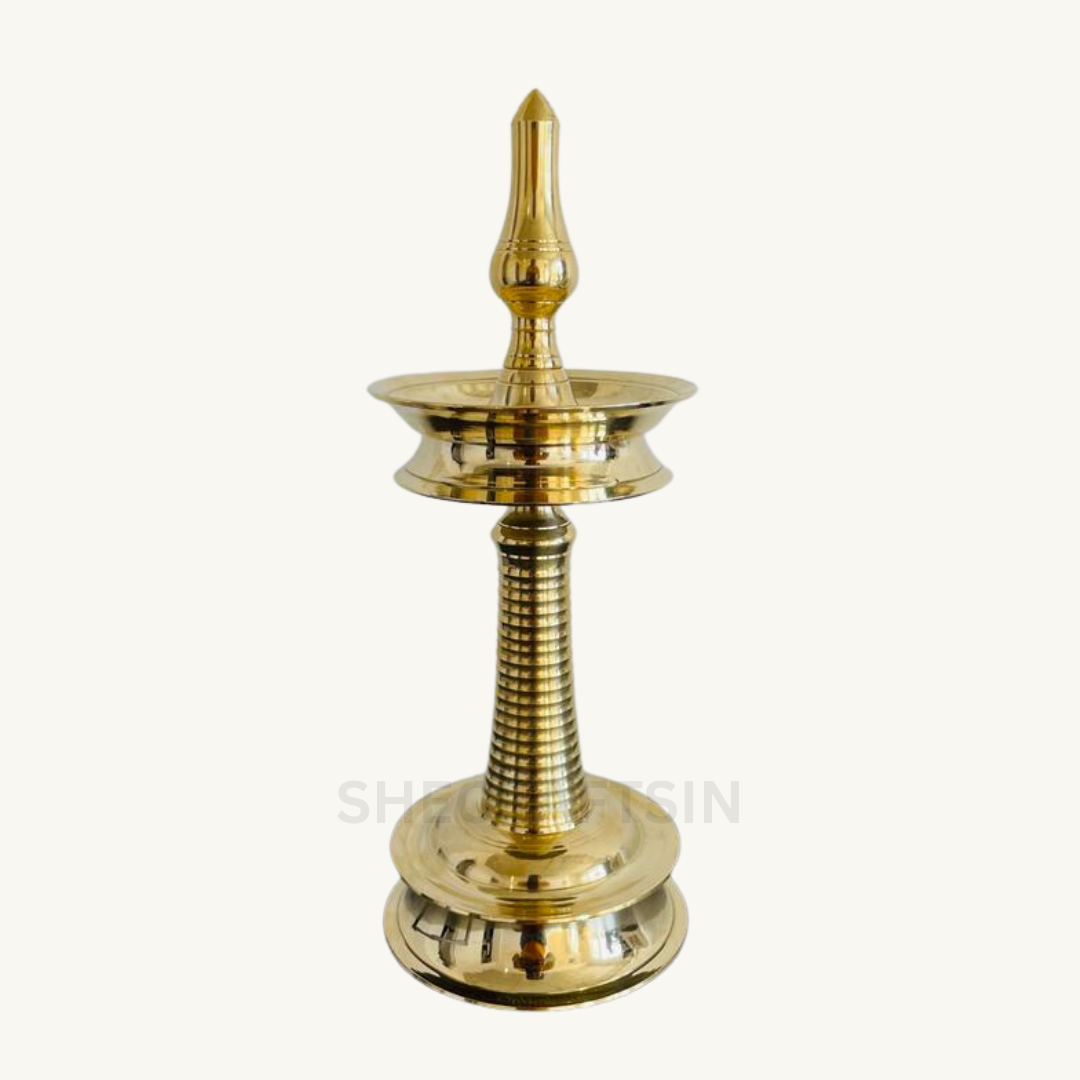Kerala, a state in southern India, is known for its rich cultural heritage and traditional handicrafts. One such traditional item is the Kerala handmade brass nilavilakku.
The nilavilakku, also known as the traditional Kerala lamp, is an important symbol in Kerala's cultural and religious practices. It is used during auspicious occasions, religious ceremonies, and festivals. The lamp consists of a circular base, a stem, and several branches with holders for oil lamps.
Handmade brass nilavilakku is crafted by skilled artisans who specialize in metalwork. They use the ancient lost wax casting technique to create these exquisite lamps. This process involves creating a wax model of the desired design, encasing it in a clay mold, and then melting the wax to leave a cavity. Molten brass is then poured into the cavity, taking the shape of the original wax model. Once the brass solidifies, the clay mold is broken, and the lamp is polished and finished by the artisans.
A Nilavilakku is a traditional lamp used in Kerala, a state in southern India. It is an integral part of Kerala's culture and is widely used in religious ceremonies, festivals, and auspicious occasions. The term "Nilavilakku" translates to "standing lamp" in Malayalam, the language spoken in Kerala.
The Nilavilakku is typically made of brass, bronze, or other metals. It consists of a circular or square base, a tall stem, and several branches extending from the stem. Each branch has holders for oil lamps or candles. The number of branches may vary, but it is usually odd, with three or five branches being common.
The lamp is filled with oil, and cotton wicks are placed in the holders. These wicks are lit, and the flame emanating from the Nilavilakku is considered sacred and symbolizes the presence of divine energy. The lamp is usually placed on a special stand or pedestal.

The Nilavilakku holds great religious and cultural significance in Kerala. It is often used during traditional rituals, such as aarti (devotional worship) in temples and homes. Lighting the Nilavilakku is believed to bring positivity, prosperity, and spiritual enlightenment.
In addition to its religious significance, the Nilavilakku is also valued as a decorative item. It is often beautifully crafted with intricate designs, engravings, and embellishments. The craftsmanship and artistry involved in making these lamps are highly appreciated.
If you are interested in acquiring a Nilavilakku, you can find them in various sizes, designs, and price ranges
Brass is chosen as the primary material for nilavilakku due to its durability, corrosion resistance, and its ability to hold and radiate heat effectively. These lamps are often embellished with intricate designs, motifs, and engravings, showcasing the craftsmanship and artistic skills of the artisans.
Kerala handmade brass nilavilakku not only serves as a functional lamp but also holds great cultural and religious significance in the state. It is considered auspicious and is often placed in temples, homes, and other sacred spaces. Lighting the nilavilakku is believed to bring prosperity, positivity, and divine blessings to the surroundings.
These handmade brass nilavilakkus are popular as decorative items and are also cherished as traditional gifts. They are available in various sizes, designs, and finishes, ranging from simple and elegant to ornate and elaborate.
A handmade oil lamp is a traditional lighting device that uses oil as fuel to produce light. Oil lamps have been used for centuries in various cultures around the world and continue to be appreciated for their aesthetic appeal and historical significance.
Handmade oil lamps are crafted by skilled artisans using a variety of materials such as clay, brass, bronze, or other metals. The process of making these lamps can vary depending on the material and the cultural context.
Clay oil lamps, for example, are often made by shaping and molding clay into the desired lamp design. The clay is then dried and fired in a kiln to harden it. Afterward, the lamp is usually painted and decorated with intricate patterns or motifs.
Brass or bronze oil lamps are typically created through a process called lost wax casting. This involves creating a wax model of the lamp design, coating it with a clay mixture, and then heating it to melt the wax, leaving a cavity. Molten brass or bronze is poured into the cavity, taking the shape of the original wax model. Once cooled and solidified, the clay mold is broken to reveal the finished lamp. The lamp is then polished and sometimes adorned with additional decorative elements.
Handmade oil lamps can come in various shapes, sizes, and designs, ranging from simple and utilitarian to highly ornate and artistic. Some lamps feature traditional cultural motifs, religious symbols, or intricate carvings that reflect the cultural heritage of the region or the artisan's creativity.
To use a handmade oil lamp, it is filled with oil (such as vegetable oil or lamp oil) and a wick is inserted into the fuel. The wick is then lit, and the flame provides a warm and ambient light source. The lamps can be placed on a suitable base or holder to ensure stability and safety.
Handmade oil lamps are often used for religious or ceremonial purposes, as well as for decorative and aesthetic purposes. They can be found in various cultural contexts and are cherished for their historical value, craftsmanship, and ability to create a unique ambiance.


